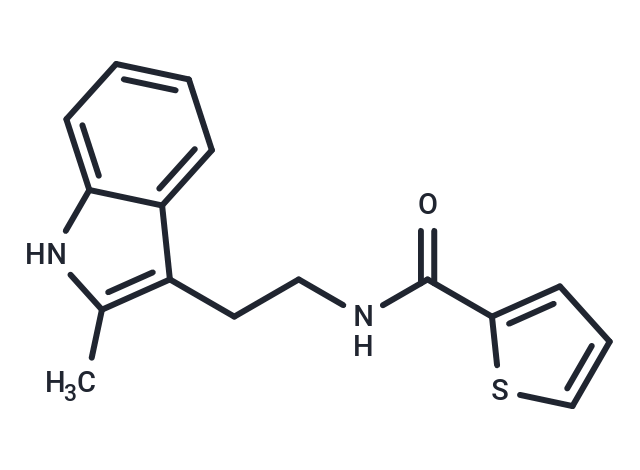Shopping Cart
Remove All Your shopping cart is currently empty
Your shopping cart is currently empty
CK-636 (CK-0944636), an Arp2/3 complex inhibitor, can inhibit actin polymerization induced by the human (IC50: 4 μM), fission yeast (IC50: 24 μM) and bovine (IC50: 32 μM) Arp2/3 complex, respectively.

| Pack Size | Price | USA Warehouse | Global Warehouse | Quantity |
|---|---|---|---|---|
| 5 mg | $30 | In Stock | In Stock | |
| 10 mg | $47 | In Stock | In Stock | |
| 25 mg | $83 | In Stock | In Stock | |
| 50 mg | $139 | In Stock | In Stock | |
| 100 mg | $198 | In Stock | In Stock | |
| 500 mg | $516 | - | In Stock | |
| 1 mL x 10 mM (in DMSO) | $32 | In Stock | In Stock |
| Description | CK-636 (CK-0944636), an Arp2/3 complex inhibitor, can inhibit actin polymerization induced by the human (IC50: 4 μM), fission yeast (IC50: 24 μM) and bovine (IC50: 32 μM) Arp2/3 complex, respectively. |
| Targets&IC50 | Arp2/3 complex (fission yeast):24 μM, Arp2/3 complex (human):4 μM, Arp2/3 complex (bovine):32 μM |
| In vivo | CK-636 slows down cell migration by inhibiting the formation of lamellipodia at the leading edge of migrating T-cells. In live cells, it suppresses actin polymerization mediated by the Arp2/3 complex. In infected SKOV3 cells, CK-636 reduces the formation of actin filaments. Moreover, a majority of T-cells treated with CK-636 exhibit a turning event upon encountering a zigzag-shaped interface during a letter-shaped test experiment. |
| Kinase Assay | HDAC inhibition assays: HDAC inhibition assays are performed by Reaction Biology Corp. using isolated human, recombinant full2length HDAC1 and -6 from a baculovirus expression system in Sf9 cells. An acetylated fluorogenic peptide,RHKKAc, derived from residues 379-382 of p53 is used as substrate. The reaction buffer is made up of 50 mM Tris-HCl pH 8.0, 127 mM NaCl, 2.7 mM KCl, 1 mM MgCl2, 1 mg/mL BSA, and a final concentration of 1% DMSO. Compounds are delivered in DMSO and delivered to enzyme mixture with preincubation of 5-10 min followed by substrate addition and incubation for 2 h at 30°C. Trichostatin A and developer are added to quench the reaction and generate fluorescence, respectively. Dose-response curves are generated starting at 30 μM compound with three-fold serial dilutions to generate a 10-dose plot. IC50 values are then generated from the resulting plots, and the values expressed are the average of duplicate trials ± standard deviation. |
| Synonyms | CK-0944636, CK 636 |
| Molecular Weight | 284.38 |
| Formula | C16H16N2OS |
| Cas No. | 442632-72-6 |
| Smiles | Cc1[nH]c2ccccc2c1CCNC(=O)c1cccs1 |
| Relative Density. | no data available |
| Storage | Powder: -20°C for 3 years | In solvent: -80°C for 1 year | Shipping with blue ice/Shipping at ambient temperature. | |||||||||||||||||||||||||||||||||||
| Solubility Information | H2O: < 1 mg/mL (insoluble or slightly soluble) Ethanol: 47 mg/mL (165.27 mM), Sonication is recommended. DMSO: 40 mg/mL (140.66 mM), Sonication is recommended. | |||||||||||||||||||||||||||||||||||
| In Vivo Formulation | 10% DMSO+40% PEG300+5% Tween 80+45% Saline: 2 mg/mL (7.03 mM), Sonication is recommended. Please add the solvents sequentially, clarifying the solution as much as possible before adding the next one. Dissolve by heating and/or sonication if necessary. Working solution is recommended to be prepared and used immediately. The formulation provided above is for reference purposes only. In vivo formulations may vary and should be modified based on specific experimental conditions. | |||||||||||||||||||||||||||||||||||
Solution Preparation Table | ||||||||||||||||||||||||||||||||||||
DMSO/Ethanol
| ||||||||||||||||||||||||||||||||||||
| Size | Quantity | Unit Price | Amount | Operation |
|---|

Copyright © 2015-2025 TargetMol Chemicals Inc. All Rights Reserved.